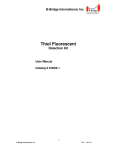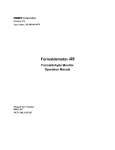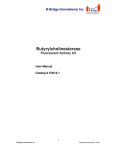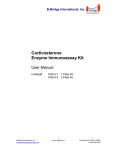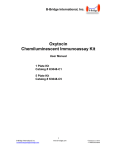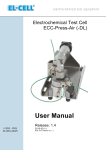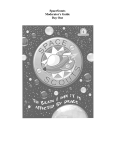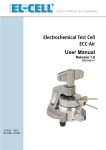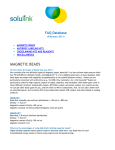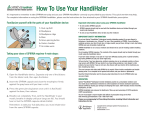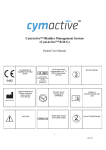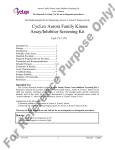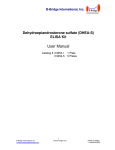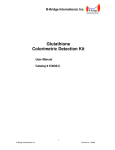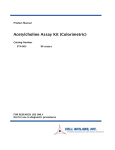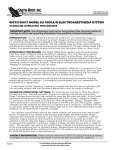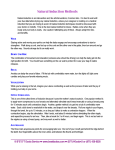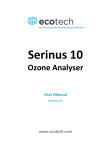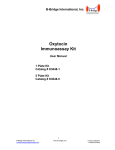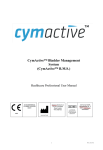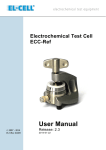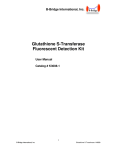Download Acetylcholinesterase - B-Bridge International, Inc.
Transcript
B-Bridge International, Inc. Acetylcholinesterase Fluorescent Activity Kit User Manual Catalog # K3015-1 1 B-Bridge International, Inc. Acetylcholinesterase 110811 TABLE OF CONTENTS Intended Use 3 Background 3 Assay Principle 3 Kit Components 4 Materials Required 4 Precautions 4 Reagent Preparation 5 Sample Preparation 6 Assay Protocol 6 Calculations 6 Typical Standard Curve: Example 7 Notice to Purchaser This product is to be used for Research Purposes Only. It is not to be used for Drug or Diagnostic Purposes, nor is it intended for Human Use. B-Bridge products may not be resold, modified for resale, or used to manufacture commercial products without the express written consent of B-Bridge International, Inc. EXCEPT AS OTHERWISE EXPRESSLY SET FORTH IN THIS USER MANUAL, B-BRIDGE DOES NOT MAKE ANY REPRESENTATION OR WARRANTIES OR CONDITIONS OF ANY KIND, EITHER EXPRESSED OR IMPLIED, WITH RESPECT TO THE PRODUCTS, OR INFORMATION DISCLOSED HEREUNDER, INCLUDING, BUT NOT LIMITED TO, THE IMPLIED WARRANTIES OF MERCHANTABILITY, FIT FOR A PARTICULAR PURPOSE, OR NONINFRINGEMENT OF THE INTELLECTUAL PROPERTY RIGHTS OF THIRD PARTIES. B-Bridge International, Inc. All Rights Reserved. 2 B-Bridge International, Inc. Acetylcholinesterase 110811 INTENDED USE The B-Bridge Acetylcholinesterase Fluorescent Activity Kit (catalog # K3015-1) quantitatively measures Acetylcholinesterase (AChE) activity in serum, EDTA and heparin plasmas, and RBC ghosts (Erythrocyte Membranes) from a variety of species. This assay is species independent. It will also measure AChE in extracted tissue samples and cell lysates. BACKGROUND Acetylcholinesterase appears critical to both development and function of the nervous system. The use of AChE inhibitors as therapeutic agents and pesticides has spurred detailed investigations of cholinesterase. Acetylcholine (ACh) is an essential neurotransmitter in the central and peripheral nervous systems. In the brain multiple areas exist where cholinergic neurons are concentrated. Nicotinic and muscarinic ACh receptors are recognized as binding and effector proteins to mediate chemical neurotransmission at neurons, ganglia, heart and smooth muscle fibers and glands. This traditional view of AChE acting solely as neurotransmitter has to be revised based on the findings published both early and late in the last century, demonstrating the non-neuronal cholinergic system. AChE Acetylcholine Acetylcholinesterase is encoded by the single AChE gene; and the structural diversity in the gene products arises from alternative nRNA splicing and post translational associations of catalytic and structural subunits. The major form of acetylcholinesterase found in brain, muscle, and other tissues is the hydrophilic species, which forms disulfide-linked oligomers with collagenous, lipid-containing structural subunits. The other alternatively-spliced form, expressed primarily in the erythroid tissues, is structurally different at the C-terminal end and contains a cleavable peptide with a GPI anchor. It associates with membrane receptors through phosphoinositide moieties added post-translational. Impairment of cholinergic neurotransmission is well-established in Alzheimer’s disease, but there is controversy about its relevance at the early stages of the disease as well as in mild cognitive impairment. In vivo positron emission tomography imaging of cortical AChE activity as a marker of cholinergic function that is expressed by cholinergic axons and neurons has demonstrated a reduction of this enzyme activity in manifest Alzheimer’s patients. Other intentional or environmental methods of with anticholinergic properties which are used as insecticides worldwide or as warfare agents. Thousands of cases of acute poisoning have been reported. This acute toxicity inhibits AChE at nerve terminals where inhibition causes accumulation of ACh. This, in turn, induces overstimulation of nicotinic and muscarinic receptors in the central and peripheral nervous systems and the consequent signs and symptoms. ASSAY PRINCIPLE The Acetylcholinesterase Fluorescent Activity kit is designed to quantitatively measure acetylcholinesterase (AChE) activity in a variety of samples. The kit utilizes a proprietary non-fluorescent molecule, Thio, that covalently binds to the thiol product of the reaction between the AChE Substrate and AChE in the standards or samples, yielding a fluorescent product read at 510 nm in a fluorescent plate reader with excitation at 390 nm. Because the readout of AChE activity is purely chemical, there are few interferants that will affect the readings obtained. 1. Sample or standard added to well. 2. The reaction is initiated with the addition of the Reaction Mix containing AChE, Substrate, and Thio Detection Reagent 3. Incubate for 20 minutes and read fluorescent signal. Calculate AChE activity from standard curve. 4. Alternatively samples can be read kinetically. Follow steps 1 and 2 above. Add Reaction Mix and read signal at 510 nm over time. Compare rates for samples and standards to determine sample AChE activity. 3 B-Bridge International, Inc. Acetylcholinesterase 110811 KIT COMPONENTS Black 96-well plates 2 plates Acetylcholinesterase Standard (1,000 mU/ml) 225 µl Thio Detection Reagent -Stored in desiccator 2 vials AChE Substrate 2 vials - Acetylthiocholine iodide freeze dried with stabilizers Dimethyl Sulfoxide Solvent (DMSO) 14 ml - DMSO will freeze at 2-8°C. May be stored at room temperature. 10X Assay Buffer 28 ml Store all components at 2-8°C, except DMSO. Store DMSO tightly capped at room temperature. MATERIALS REQUIRED BUT NOT SUPPLIED - Deionized or distilled water - Isotonic saline (0.9%) - Triton X-100 - Centrifuge - Fluorescence 96-well plate reader capable of reading fluorescent emission at 510 nm with excitation at 390 nm. -Software for converting raw relative fluorescent unit (FLU) readings from the plate reader and carrying out four parameter logistic curve (4PLC) fitting. PRECAUTIONS This kit should only be used by qualified personnel who have had laboratory safety instruction. The complete User Manual should be read and understood before using this product. Dimethyl sulfoxide (DMSO) is a powerful aprotic organic solvent that has been shown to enhance the rate of skin absorption of skin-permeable substances. Wear protective gloves, safety glasses and clothing when working with DMSO. Consult your institution’s safety procedures for working with hazardous chemicals. The Acetylcholinesterase Standard is derived from human erythrocytes. It has been extensively tested for viral contamination, but all human blood products should be treated as potentially infectious and adequate precautions taken. Protective clothing, gloves, and safety glasses should be worn. Consult your institution’s safety procedures for working with human samples. Thio Detection Reagent should be stored at 4°C in the desiccator. Allow the desiccator to warm to room temperature prior to opening. Thio Detection Reagent will react with strong nucleophiles. Buffers containing the preservatives sodium azide, Proclin™ and Kathon™ will react with the substrate. 4 B-Bridge International, Inc. Acetylcholinesterase 110811 REAGENT PREPARATION Allow the kit reagents to come to room temperature for 30 minutes. We recommend that all standards and samples be run in duplicate to accurately determine AChE activity. Ensure that all samples have reached room temperature and have been diluted as appropriate prior to assaying. 1X Assay Buffer Prepare a 1X Assay Buffer by diluting 1 part 10X Assay Buffer with 9 parts deionized water. 1X Assay Buffer is stable for up to 3 months at 4°C. 10X Thio Detection Reagent Make a 10X Thio Detection Reagent by adding 700 µl of DMSO to 1 vial of Thio Reagent, vortex thoroughly. Store any unused reconstituted Detection Reagent at 4°C in the desiccator and use within 2 weeks. 10X Acetylcholinesterase Substrate Make a 10X AChE Substrate Reagent by adding 700 µl of DMSO to 1 vial of AChE Substrate, vortex thoroughly. Store any unused reconstituted AChE Substrate at room temperature and use within 2 weeks. Reaction Mix Follow the table below to make the appropriate volume of Reaction Mix. Use the Reaction Mix within 1 hour of preparation. Protect from light. 10X AChE Substrate 10X Thio Detection Reagent DMSO Half Plate 300 µl 300 µl 2.4 ml Whole Plate 550 µl 550 µl 4.4 ml Standard Preparation AChE Standards are prepared by labeling five test tubes as #1 through #5. Briefly spin vial of standard in a microcentrifuge to ensure contents are at bottom of the vial. 1. Pipet 450 µl of 1X Assay Buffer into tube #1 and 250 µl into tubes #2 to #5. 2. Carefully add 50 µl of the AChE Standard to tube #1 and vortex completely. 3. Take 250 µl of the AChE solution in tube #1 and add it to tube #2 and vortex completely. 4. Repeat these serial dilutions for tubes #3 through #5. The activity of AChE in tubes 1 through 5 will be 100, 50, 25, 12.5, and 6.25 mU/ml. Use all standards within 2 hours of preparation Reagent Assay Buffer Volume AChE Stock Standard 1 Standard 2 Standard 3 Standard 4 Final Concentration (mU/mL) Standard 1 450 µl 50 µl Standard 2 250 µl Standard 3 250 µl Standard 4 250 µl Standard 5 250 µl 250 µl 250 µl 250 µl 100 50 25 12.5 250 µl 6.25 5 B-Bridge International, Inc. Acetylcholinesterase 110811 SAMPLE PREPARATION Serum and Plasma Store serum or plasma on ice until assaying or freeze in aliquots for later use. Samples containing visible particulate should be centrifuged prior to using. Samples must be diluted in 1X Assay Buffer prior to assaying. Serum and plasma typically have to be diluted ≥ 1:300 to read in the assay. Any samples with AChE activity outside the standard curve range should be diluted further with 1X Assay Buffer to obtain readings within the standard curve. Use all samples within 2 hours of dilution Erythrocytes (RBCs) Blood is collected in the presence of heparin or EDTA. The sample is then centrifuged and the plasma and white cell layer are removed from the RBC layer. The RBCs are suspended and gently washed twice with three volumes of isotonic saline (0.9%), separating the cells by centrifugation at 600 x g for 10 minutes and discarding the saline after each step. To lyse the RBCs, four volumes of cold deionized water are added to the RBCs. The cells are then vortexed and incubated for 10 minutes at 4˚C, or allowed to undergo a freeze/thaw. Samples are centrifuged at 14,000 rpm for 10 minutes at 4˚C and the supernatant discarded. Further wash the membrane pellet with two or three volumes of isotonic saline, with centrifugation in between, until it is only slightly pink. The smaller dark red pellet on the bottom is non-lysed RBCs and should be avoided. Solubilize the white membrane ghost pellet with Triton X-100. Dilute solubilized RBC ghost with 1X Assay Buffer. Final assay dilution of the solubilized RBC ghost sample must be sufficient that the assay sample contains ≤ 0.01% Triton X-100. Use all samples within 2 hours of dilution ASSAY PROTOCOL Standards and samples should be run in duplicate 1. Pipet 100 µl of samples or standards into duplicate wells in the plate 2. Pipet 100 µl of 1X Assay Buffer into duplicate wells as a zero standard. 3. Add 50 µl of prepared Reaction Mix to each well using a repeater or multi-channel pipet 4. Gently tap the sides of the plate to ensure adequate mixing of reagents 5. Incubate at room temperature for 20 minutes 6. Read the fluorescent emission at 510 nm with excitation at 370-410 nm. CALCULATIONS Average the duplicate fluorescent unit (FLU) readings for each standard and sample. Create a standard curve by reducing the data using the 4PLC (4 parameter logistic curve) fitting routine on the plate reader, after subtracting the mean FLU for the zero standard. The sample activity obtained should be multiplied by the dilution factor to obtain neat sample values. 6 B-Bridge International, Inc. Acetylcholinesterase 110811 TYPICAL STANDARD CURVE: EXAMPLE ONLY Standard curves vary with each assay. Always run your own standard curves for calculation of results; do not use this data 7 B-Bridge International, Inc. Acetylcholinesterase 110811







